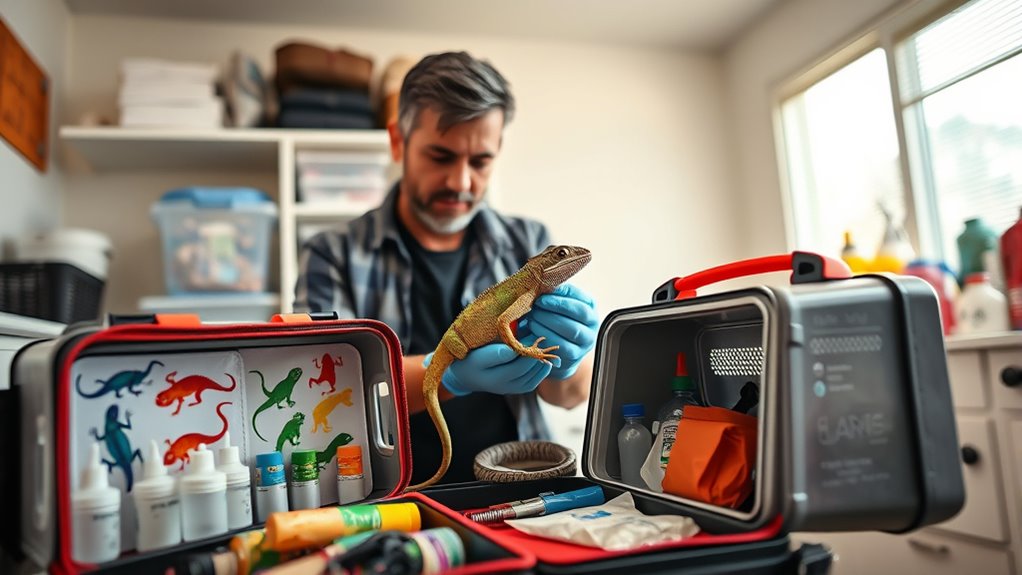To prepare your exotic pets for emergencies, assemble a portable emergency kit with at least 72 hours of food, water, medications, and comfort items like towels or toys. Use appropriate carriers that keep your pets secure and calm during transit, handling them gently. Regularly check and practice how you pack and move your pets to guarantee quick, effective action. Keep all medical records and emergency contacts handy. If you’re ready to learn more, keep going for detailed tips on emergency preparedness.
Key Takeaways
- Use appropriate, secure carriers tailored to each exotic pet’s size and needs for safe transportation.
- Pack an emergency kit with food, water, medications, and comfort items for at least 72 hours.
- Keep updated medical records and contact info for your veterinarian readily accessible.
- Practice quick packing and securing procedures regularly through drills to ensure household preparedness.
- Familiarize yourself with emergency procedures specific to your exotic pets to minimize stress and ensure safety.

Emergencies can strike unexpectedly, and preparing your exotic pets for such situations is essential to guarantee their safety and well-being. When disaster hits, quick and effective action can be the difference between life and death for your unique companions. One of the most critical aspects of emergency preparedness is guaranteeing transportation safety. If you need to evacuate, you must know how to transport your exotic pets securely. Use appropriate carriers designed for their specific needs—ventilated, sturdy, and escape-proof. For reptiles, a well-ventilated plastic container with a secure lid works best, while birds may require a cage that provides enough space but is easy to carry. Always secure the carrier in your vehicle to prevent jostling or tipping over during transit. Avoid overcrowding, and make sure your pets are comfortable and calm during the move. Remember, sudden movements or rough handling can cause stress or injury, so handle them gently and remain composed.
Equally important is assembling an emergency kit with essentials tailored to your exotic pets. Your kit should include enough food and water to sustain them for at least 72 hours, along with any medications or supplements they require. Include a clean, damp cloth or small towels to help with cleaning or to provide comfort. For reptiles and amphibians, pack a heat source or heating pad, if applicable, because temperature regulation is critical during emergencies. For birds and small mammals, include items like chew toys or nesting materials to reduce stress. Consider packing a basic first aid kit, with items such as antiseptic solution, bandages, and tweezers. Also, keep a list of your pets’ specific needs, medical history, and contact information for your veterinarian. This documentation can be invaluable if you need to seek emergency assistance.
Preparing for emergencies isn’t just about having supplies—it’s about practicing the process. Familiarize yourself with how to quickly pack and secure your pets, and run drills so that everyone in your household knows what to do. Regularly check your emergency kit to guarantee items are in good condition and not expired. Staying organized and proactive ensures you’re ready to act swiftly, minimizing stress for your pets and maximizing their safety during any crisis. Ultimately, your preparedness can make all the difference, giving your exotic pets a better chance to stay safe and healthy no matter what challenges come your way.
Frequently Asked Questions
How Do I Identify Signs of Stress in My Exotic Pet During Emergencies?
During emergencies, you can identify signs of stress in your exotic pet by observing behavioral cues like excessive hiding, pacing, or rapid breathing. Signs of anxiety may include loss of appetite, trembling, or aggressive behaviors. Pay close attention to any sudden changes in activity levels or posture. Recognizing these signs early helps you respond quickly, reducing your pet’s stress and ensuring their safety during stressful situations.
What Should I Include in an Emergency Kit Specifically for Exotic Animals?
Think of yourself as a modern-day MacGyver, ready for any challenge. Your exotic pet’s emergency kit should include first aid supplies like antiseptic, bandages, and tweezers, along with habitat essentials such as heat sources, water, and food. Don’t forget specialized items like medication or supplements your pet needs. With these in your kit, you’ll be prepared to handle surprises and keep your exotic companion safe during emergencies.
How Often Should I Practice Emergency Evacuation Drills With My Exotic Pet?
You should practice emergency evacuation drills with your exotic pet at least twice a year. During these drills, focus on habitat safety and test different transportation methods to make certain your pet remains secure and comfortable. Rehearsing helps you identify potential issues, like securing enclosures or selecting the best transport options. This way, you’re better prepared to evacuate quickly and safely if an emergency arises, minimizing stress for your exotic pet.
Are There Special Considerations for Exotic Pets With Unique Habitat Needs?
Sure, your exotic pet’s habitat might be a little high-maintenance, but hey, who doesn’t love a little extra work? When considering habitat customization, you’ll need to think about their unique needs, like temperature, humidity, and space. Don’t forget species-specific nutrition—ignoring these details could turn your pet’s emergency into a disaster. Tailoring care guarantees they stay safe, healthy, and ready for anything.
How Can I Find a Nearby Emergency Veterinarian Experienced With Exotic Species?
You can find nearby emergency veterinarians experienced with exotic species by checking veterinary contacts online, calling your regular vet for recommendations, or visiting specialized exotic animal clinics. Make certain you have their contact info readily available for emergency preparedness. It’s also helpful to join exotic pet owner groups or forums, where members often share trusted veterinary contacts. Being proactive ensures you’re prepared to get prompt, appropriate care when your exotic pet needs it most.
Conclusion
By preparing your exotic pet for emergencies, you’re building a safety net that can catch them when times get tough. Stay proactive and keep emergency plans ready—think of it as planting seeds of security that will bloom into peace of mind. Just like a sturdy foundation supports a grand structure, your preparedness offers your pet a safe haven amid life’s storms. With your foresight, you become their guardian angel in times of crisis.










